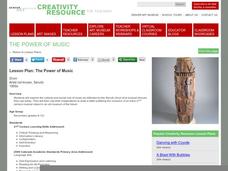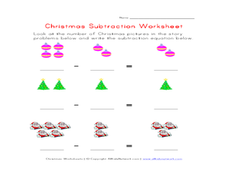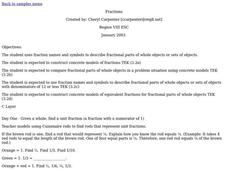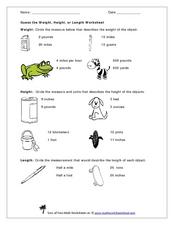Curated OER
"Snapshot" Exercises & Sensory Detail Word Bank
Read a sample of creative descriptive writing to your science class. Discuss how writing can be used to record and communicate observations that scientists make. Reading selections and thought-provoking questions are suggested. Also...
Corbett Maths
Enlargements with Negative Scale Factor
How will a scale factor affect a figure—negatively? Using a grid, the narrator of an engaging video performs a dilation with a negative scale factor. The presenter compares a positive scale factor with a negative scale factor to explain...
American Museum of Natural History
Optical Illusions and How They Work
Illusions are what your mind makes them. Learners view several optical illusions. After each illusion the resource describes what is seen and the potential connection to evolution of the brain. Illusions include seeing different objects...
EngageNY
Slicing a Rectangular Prism with a Plane
What do you get when you slice a prism? Pupils discover that the answer depends on how the prism is sliced. The second half of the 29-part module focuses on three-dimensional objects. Learners use their two-dimensional vocabulary and...
Curated OER
Lesson: The Power of Music
The sounds of the past echo through art and our social understanding. Will the sounds of today echo into the future? Learners discuss the cultural and social impact of music, then analyze the art on an African Drum. They develop...
Curated OER
Christmas Subtraction Worksheet
Find the differences by counting the Christmas objects that correspond to the word problem. There are 3 problems total each requiring learners to write the equation that describes their answer.
Curated OER
Above, On, Below, part 2
Prepositions describe where something is in space or time. Little learners discover the prepositions about, on, and below. They locate and count objects in each position as they are located in relation to the ground. They then record the...
Super Teacher Worksheets
Reading a Map
Young geographers improve their map skills by practicing locating the cardinal directions on a map, identifying symbols on a map key, and describing where objects on the map are located relative to other locations.
Curated OER
Do You See What I See?
Students engage in a instructional activity that differentiates between right and wrong types of observations. In order to conduct the experiment they are provided with leaves and nameless objects with different designs. The two are...
Curated OER
Fractions
Young mathematicians use fraction names and symbols to describe fractional parts of whole objects or sets of objects. They construct concrete models of fractions, and compare fractional parts of whole objects in a problem situation using...
Curated OER
Old Made New
Students explore recycling. In this science lesson, students sort everyday objects based on their properties. Students view examples of items made from recycled paper. Students create recycled paper.
Curated OER
Line With Printmaking
Third graders investigate the use of lines in different pieces of art by creating their own ink print. In this art analysis lesson, 3rd graders identify the contours and lines of natural objects such as twigs and leaves. Students...
Curated OER
Texture Sculpture
Students explore a variety of everyday objects and group them according to their textures. They create a clay portrait, learning how to manipulate the material and tools to create different textures.
Curated OER
Guess the Weight, Height, or Length Worksheet
Kids can estimate weight, length, and height. Here, they circle the measurement that best describes the length, height, or weight of 10 different objects.
Curated OER
Crash Test Dummies
Fifth graders are introduced to Newton's First Law of Motion. In groups, they describe the differences between balanced and unbalanced forces. They participate in experiments that demonstrate how equal and opposite forces act upon...
Curated OER
Tony Cragg-Evidence
Students demonstrate an understanding of basic elements and principles of art making such as unity, variety, movement, and meaning found in daily experiences. They also describe the meaning of students¿ own artwork in a written statement.
Curated OER
Electricity and Magnetism
Make oral presentations electric and magnetic! As the conclusion of the study of electricity and magnetism, class members are assigned to bring to life items or people associated with these topics. Speaking as the person or object,...
Curated OER
What Color is It?
Learners indentify whether an objects reflects or absorbs red, green, and/or blue light. They create a simple spectral signature.
Curated OER
Perception and Observation
Students use common and unusual objects to make observations of details, design, and functionality. They describe and draw each object while working in small groups. The differences between observation and perception is covered as part...
Curated OER
Walking on Water
High schoolers use this problem to help them to relate to force vectors: Suspend a meterstick horizontally between two tables. Place a 1kg mass in the middle of the meterstick. Notice the bend of the meterstick. Explain why the...
Curated OER
A Practical Application For Area
First graders investigate the concept of surface area and find the coverage for the surfaces in a building that includes carpet or walls. The application of finding the area is practical using the everyday objects to help them to make...
Curated OER
Relative Position Step-by-Step Lesson
Kindergartners demonstrate their ability to describe the relative positions of two objects. The two problems at the top of the instructional activity are followed by written and illustrated explanations of the meanings of inside and...
Curated OER
I Am, Am Not! Project
Get your class writing with this project idea. Kids choose two pictures of objects that are like them and two pictures of objects that are not like them to entice their readers. Then, they write an informative paragraph describing each...
Curated OER
"Tis The Season" Bulletin Board
Students explore a variety of objects which represent the various seasons as a preparation for writing about their birthday and the season in which it is located.























